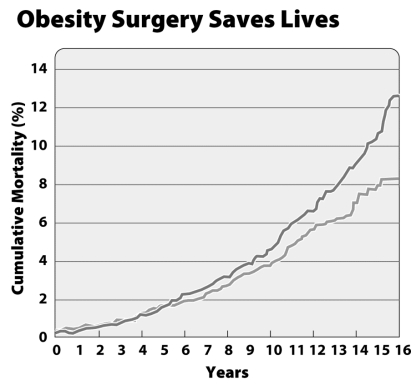The following two questions require interpretation of the graph below:

-In 2007,Swedish researchers published results from a study in which they followed about 2000 obese patients who had undergone weight-loss surgery-either gastric bypass or surgical banding-over 15 years and compared them with about 2000 similarly obese people who didn't have surgery but who were counseled in diet and exercise.One goal of the study was to determine whether bariatric surgery saved lives as a consequence of reducing patients' weights.This graph illustrates some of their results.Based on these results and what you know about the pros and cons of bariatric surgery,would you recommend it as a good treatment for morbid obesity? Explain.
Definitions:
Administer Enema
The process of introducing a fluid into the rectum and colon via the anus to stimulate bowel movement or for diagnostic purposes.
Diarrhea
A condition characterized by the frequent passage of loose or liquid stools, often a symptom of an infection or digestive system issue.
Serum Bicarbonate Level
A measurement of the concentration of bicarbonate (HCO3-) in the blood, which is an important parameter in assessing the acid-base balance of the body.
Distended Abdomen
An abdominal swelling or increase in size, which can be due to various causes such as gas, fluid accumulation, or the presence of mass.
Q14: Define shivering.<br>
Q28: A hormone that regulates blood-glucose levels is<br>A)
Q33: Why do LDL and HDL have to
Q34: In the face of rising temperatures,which organism
Q39: All of the following are true of
Q58: What percentage of energy in a food
Q79: Which is NOT true of greenhouse gases?<br>A)
Q87: All of the following are reasons for
Q91: The small intestine receives secretions from the
Q98: How do the population curves of predator